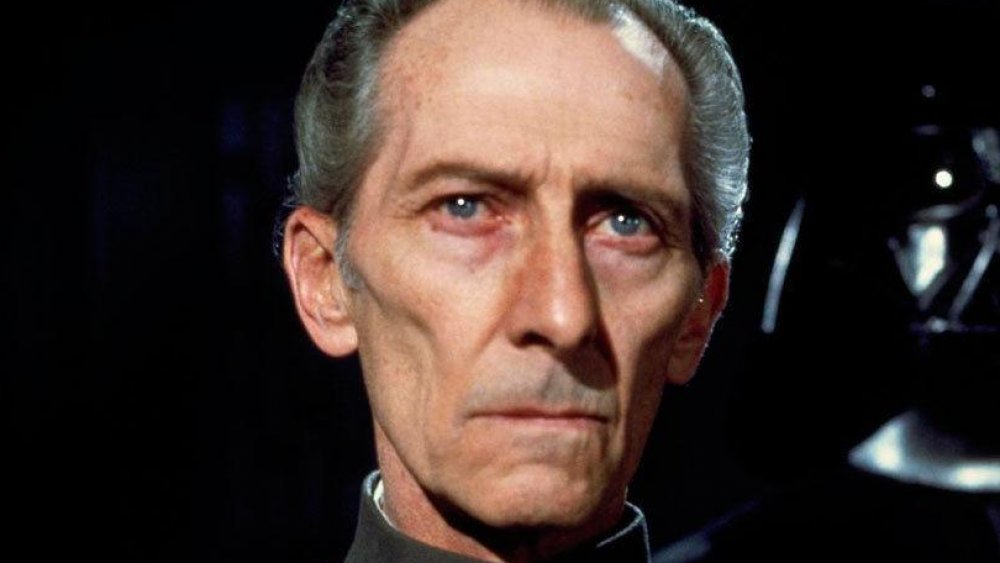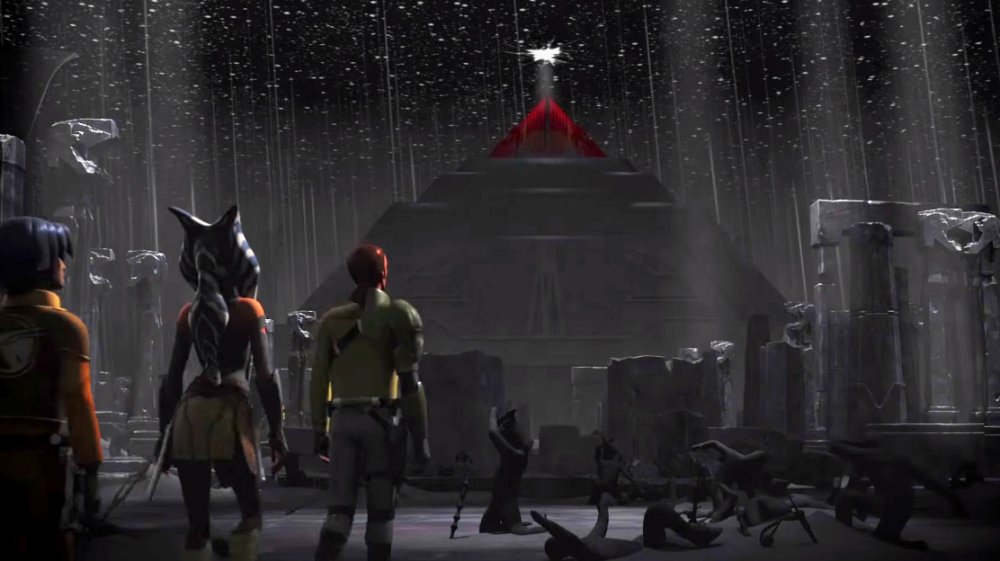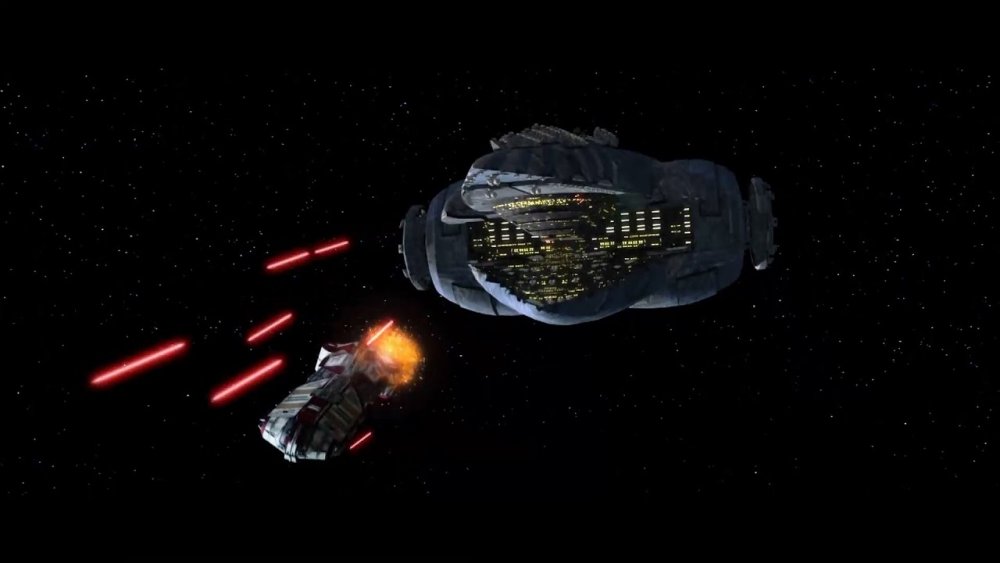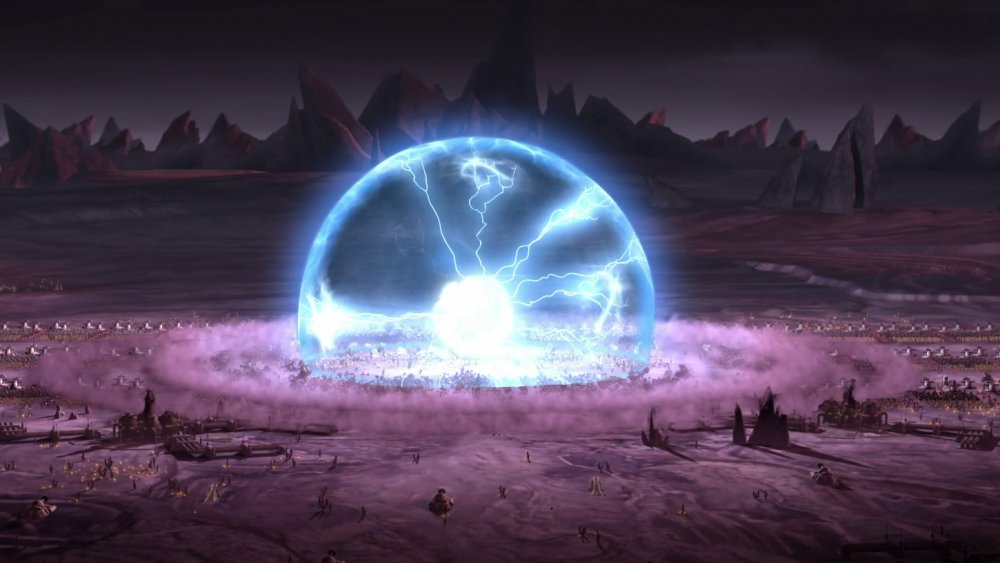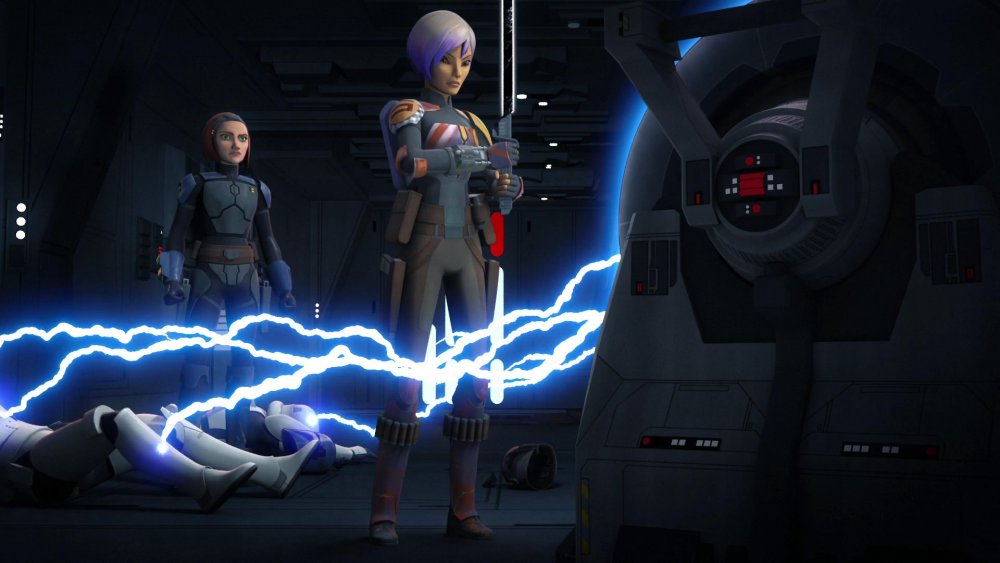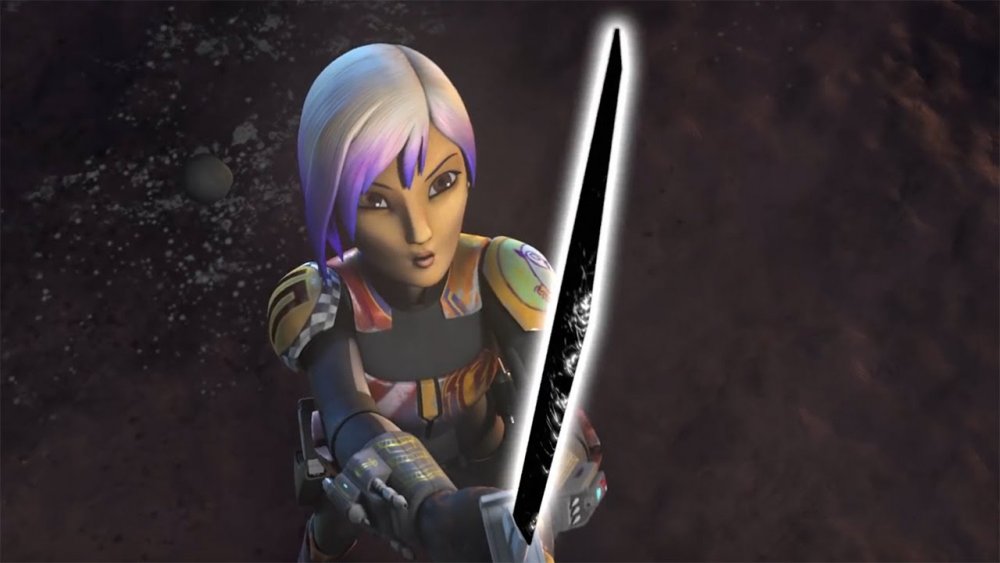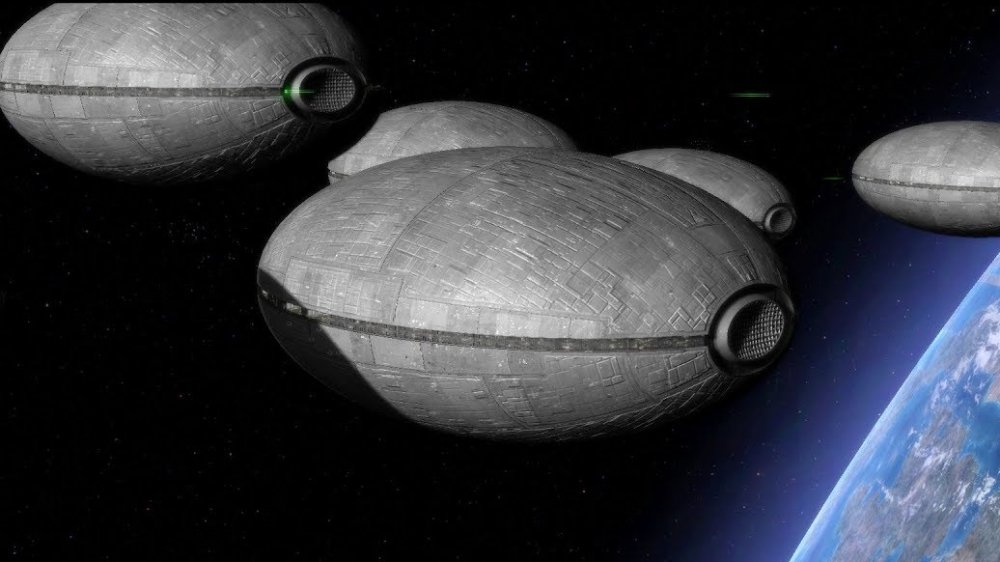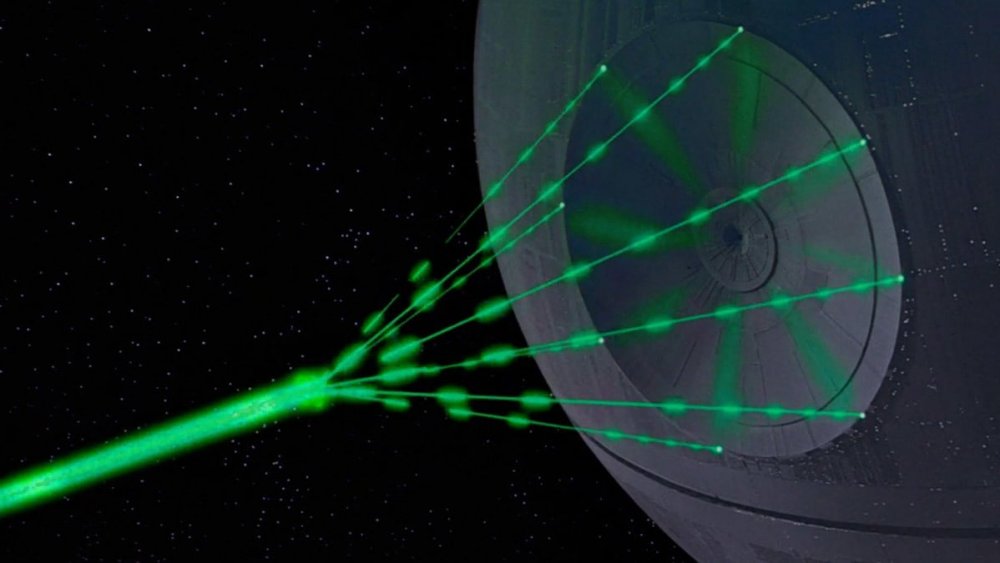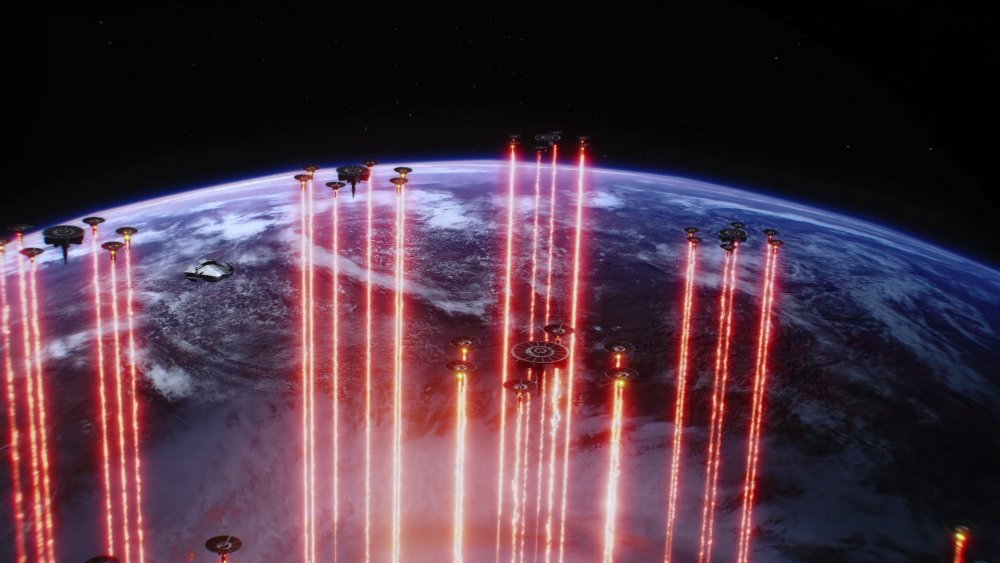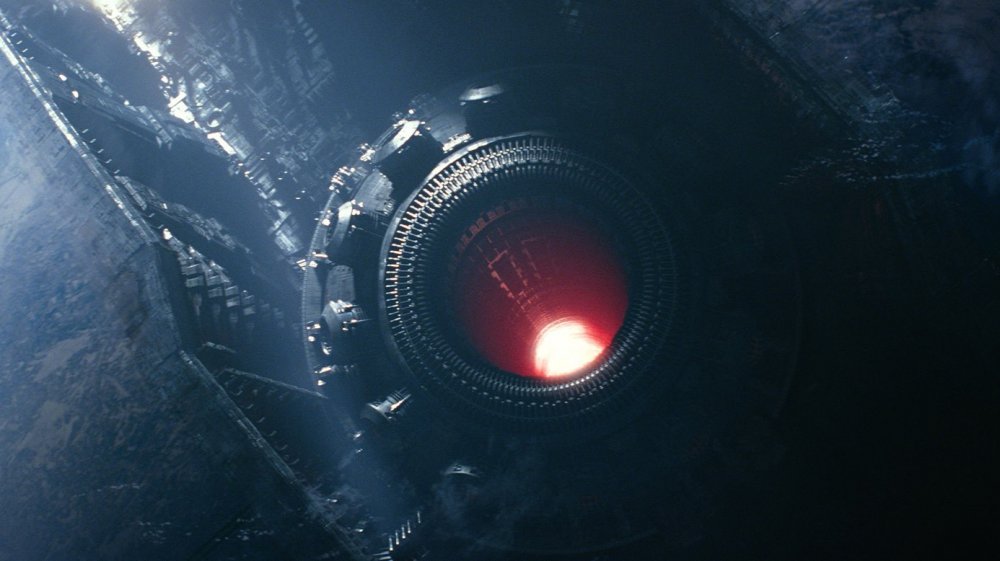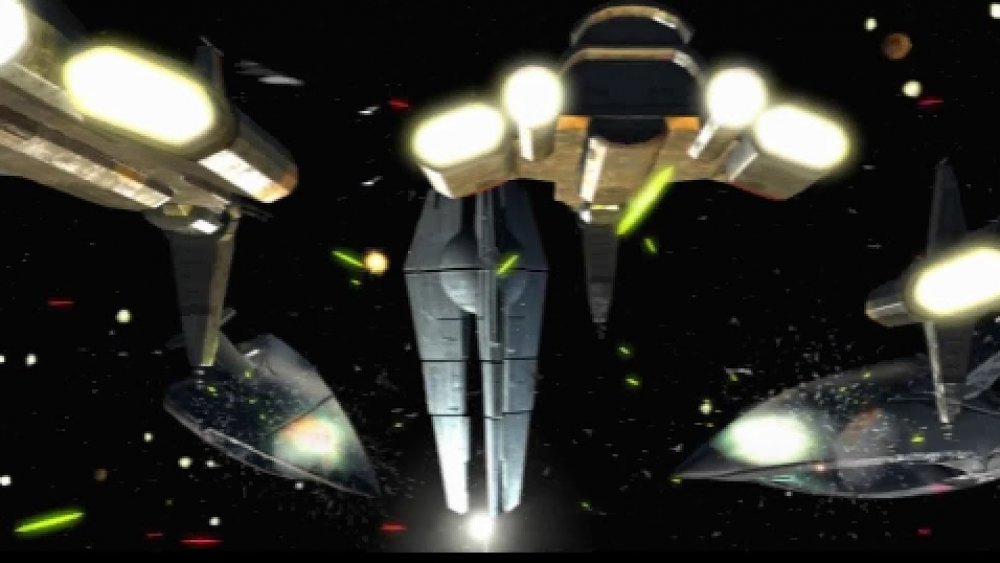The Most Powerful Weapons In The Star Wars Universe
The best thing about Star Wars isn't its collection of weird, funky aliens. It's not the distinctive, cobbled-together spaceships. It's not the plucky, ramshackle droids, or the exotic extraterrestrial locales. It is, hands down, the weapons.
Remember the first time you swung around a broomstick, making swooshing noises as you pretended to duel Darth Vader? Dreamed what it would be like to fire Han Solo's trusty DL-44 blaster pistol? Dying to get your hands on Chewbacca's bowcaster, Rey's staff, or Darth Maul's double-bladed lightsaber? Yeah, you're not alone.
And yet, while all of those weapons are cool, they're small potatoes compared to the big guns. In the Star Wars universe, bigger is better — and in terms of sheer power, these hulking monstrosities can't be beat. A blaster might be a good defense against a stormtrooper, but these superweapons can topple armies and destroy entire planets. They're the most powerful weapons in the Star Wars universe. Let's hope they never fall into the wrong hands.
The Malachor superweapon
Thousands of years before the Galactic Republic fell and the Empire rose, the Jedi and the Sith fought for control of the galaxy. One battle took place on the planet Malachor. Launching an assault on a Sith temple, Jedi forces hoped to topple a powerful Sith witch, tipping the balance of the conflict away from the dark side of the Force.
However, the Jedi didn't know that the temple wasn't just a place of worship. It was also a superweapon powered by a giant kyber crystal, similar to the ones that powered the Death Star and the Jedi and Sith's lightsabers. During the fight, the weapon went off, turning every single person inside the temple to stone. Both Jedi and Sith alike were affected. No one was spared.
The event came to be known as the Great Scourge of Malachor, and became famous as a cautionary tale for young Jedi-in-training. Centuries after the Scourge, Darth Sidious took his apprentice Darth Maul to Malachor, where Maul inhaled the remains of the fallen Sith warriors and saw visions of the calamity. As seen on Star Wars Rebels, Maul later returned to Malachor and tricked young Ezra Bridger into activating the superweapon. The Jedi Kanan Jarrus shut the weapon down before it fired, destroying the temple and keeping it out of Darth Vader's hands.
The Malevolence
Ultimately, it didn't matter whether the Republic or the Separatists won the Clone Wars — soon-to-be Emperor Palpatine was pulling the strings on both sides — but the conflict almost ended much earlier thanks to a Separatist superweapon known as the Malevolence. While the Malevolence was technically a Subjugator-class heavy cruiser, the ship was capable of destroying entire fleets in one go. The Malevolence's dual mega-ion cannons disabled the ships, and then its massive turbolaser array finished them off.
Nobody survived the Malevolence's early attacks, meaning no witnesses were left behind. As a result, the Republic started calling the Malevolence "the mystery weapon." Eventually, Jedi Master Plo Koon faced off against the Malevolence. While Kloon lost the battle, he survived the attack and was able to tell the Republic about the Malevolence's capabilities. Later, Anakin Skywalker led a squad of Y-wings against the Malevolence but couldn't pierce the ship's heavy armor.
Ultimately, the Jedi had to destroy the Malevolence from the inside. While rescuing Padme Amidala from the Separatist forces, Anakin and Obi-Wan Kenobi infiltrated the Malevolence. Before leaving, Anakin fiddled with the Malevolence's navigation systems. The next time the Malevolence tried to jump into hyperspace, it crashed right into the Dead Moon of Antar, ending its threat completely.
The Electro-proton bomb
When you're fighting against a robot army, an explosive that can disable electronics comes in pretty handy. That's why the Republic developed the Electro-proton bomb during the Clone Wars, creating a superweapon that could decimate entire droid armies while leaving the clone forces unharmed.
Unfortunately, the Electro-proton bomb was a little too powerful. When it went off on the planet Malastare, it blew a massive hole in the ground, sending clone soldiers plummeting to their death. Even worse, the environmental damage inflicted by the electro-proton bomb woke up a vicious predator known as the Zillo Beast, which had a deadly spiked tail and armored plates that even a lightsaber blade couldn't pierce.
The Republic never used the Electro-proton bomb again, but according to The Rebel Files, the Empire later combined the weapon with the Separatists' defoliator, which was used to destroy organic matter while preserving machines. It's not clear if the hybrid bomb was ever used, although we're guessing not. If something that powerful had gone off, you'd think someone would've known about it.
The Arc-Pulse Generator
Star Wars Rebels' Sabine Wren wasn't always a good guy. Before the artsy Mandalorian joined the crew of the Ghost, she was a cadet at the local Imperial Academy. While in school, Sabine used her mechanical know-how to create a weapon called the Arc-Pulse Generator, which could target specific compounds used to make armor in order to fry the people inside.
Sabine thought she was doing good. She even nicknamed the Arc-Pulse Generator "Duchess" in honor of the late Mandalorian leader Satine Kryze, who advocated for peace. Unfortunately, she was working for the Empire. Imperial forces used the Arc-Pulse Generator against the Mandalorians, focusing the weapon on the beskar they used to forge their armor. Sabine denounced the Empire and was forced into exile, and while she managed to disable the Arc-Pulse Generator, she left her research in the hands of the Empire.
Later, the Empire built a new Arc-Pulse Generator, giving Sabine a chance to redeem herself. As civil war raged on Mandalore, Sabine infiltrated the Star Destroyer where the weapon was kept, purged her research from the Imperial databanks, and targeted stormtrooper armor with the Arc-Pulse Generator, decimating the Imperial army before destroying the device completely.
The Darksaber
Regular old lightsabers have nothing on the Darksaber. The ancient blade was forged a thousand years before the Galactic Civil War by Tarre Vizsla, the first Mandalorian Jedi, and remained a potent symbol of Mandalorian authority for a millennium. It's been wielded by everyone from Pre Vizsla, head of the Mandalorian terror cell Death Watch, to Darth Maul to Sabine Wren before finally making its way to the hands of Bo-Katan Kryze, who reunited Mandalore's warring factions and turned them against the Empire.
The Darksaber is most notable for its striking black blade, which was shorter than a traditional lightsaber's and which resembles a Japanese katana more than a stick of light. The Darksaber also seems to have some extra perks that other lightsabers don't have — it crackles with energy when its wielder gets angry, and seems to attract other lightsaber blades — but its real power is what it symbolizes. When you hold the Darksaber, the Mandalorians know you're the one in charge.
The Torpedo Sphere
One of the deadliest weapons created during the Galactic Civil War actually had its roots in the days before the Clone Wars. As detailed in The Rebel Files, a collection of in-universe documents allegedly pilfered from an old Rebel base, the Galactic Republic began developing the Torpedo Sphere, a two-kilometer-wide orbital platform armed with hundreds of proton torpedo launchers, after the Invasion of Naboo.
In many ways, the Torpedo Sphere was a proto Death Star. While it required lots of coordination — heavy weapons specialists had to calibrate and target each one of the torpedo tubes manually, a process that could take hours — the targeted barrage could blow holes in planetary defense shields, paving the way for space-based turbolasers to launch attacks on the ground.
However, the Republic wasn't yet in the war business, and it didn't have the funds for the project, so the Torpedo Sphere was scrapped. That changed after the Republic became the Empire. A few years before the Death Star destroyed Alderaan, transmitter traffic from the Loronor system, as well as information on the various parts being purchased by Imperial agents, indicated that an entire fleet of "battlemoons" was in production, although we don't know if those plans ever paid off.
The Death Star
This is the one that changed everything. Before the Death Star, the Empire kept control via a combination of force, subterfuge, and political manipulation. Once the supersized battlestation was complete, none of that was necessary. With the power to destroy entire planets in his back pocket, Emperor Palpatine disbanded the Imperial Senate and began to rule through fear alone. He never looked back.
The Death Star began life in the Clone War era, when the mechanically-inclined Geonosians shared their plans for a superweapon with Separatist leader Count Dooku. Dooku gave those plans to his master, Palpatine (also known as Darth Sidious). Construction lasted for about 20 years. Galen Erso, an expert on kyber crystals, designed the Death Star's powerful laser, which ultimately decimated Jedha and Alderaan before the Death Star was destroyed by Luke Skywalker (with some help from Galen's daughter, Jyn).
That wasn't the end. After Yavin, the Emperor rushed a bigger, more powerful Death Star into production. Unlike its predecessor, the second Death Star powered up in minutes, not hours, and could be used on smaller targets, like enemy spacecraft. Ultimately, though, it wasn't much harder to stop. A Rebel assault ended the Death Star threat before it even began, leading to the Empire's decline.
The Operation: Cinder satellites
Endor may have been the beginning of the end, but the Emperor's tyranny didn't die with Palpatine. Before his demise at Darth Vader's hands, the Emperor put plans in place that would ensure that both the Rebel Alliance and the Galactic Empire would fall in the event that the Emperor was ever killed. In one part of the plan, which was known as Operation: Cinder, worlds that were important to the Empire or had personal significance to Palpatine were targeted for destruction. If Palpatine couldn't have them, no one could.
Operation: Cinder unfolded via a series of satellites that disrupted local weather patterns, creating electrical storms and hurricanes that ravaged the planets below. The "Imperial utiopa" on Vardos, one of the most loyal worlds in the Empire's collection, was one of the first to suffer under Operation: Cinder. The Emperor's homeworld, Naboo, was another Operation: Cinder target.
Other affected planets included Burnin Konn, a valuable mining facility, and worlds like Abednedo and Commenor that sympathized with the Rebel Alliance. Operation: Cinder lasted for three months, and while the Rebels — now operating as the New Republic — did their best to rescue as many lives as possible, they couldn't save everyone. Even dead, Palpatine remained a grave threat.
Starkiller Base
You think the Death Star was bad? It's nothing compared to Starkiller Base, the colossal superweapon that wipes out the entire New Republic in The Force Awakens. Starkiller Base isn't just a world-destroying behemoth. It can obliterate entire solar systems in a single shot, which can be fired from anywhere in the galaxy. It's not the size of a small moon. It's built out of an entire planet, which the First Order converted into a mobile battle station to suit its needs.
All that force takes a lot of power, however, and that ultimately ended up being Starkiller Base's downfall. In order to charge its weapons, Starkiller needed to consume an entire sun. That's a lot of energy, and it's not easy to contain. It only took a small team of Resistance fighters, led on the ground by Han Solo and in the air by Poe Dameron, to take out Starkiller's thermal oscillator. Without that protection, the First Order technology couldn't keep the energy in check and the entire planet blew apart, forming a brand new star.
The Star Forge
Star Wars: Knights of the Old Republic is in an interesting place in Star Wars canon. On one hand, Disney has declared that every piece of Star Wars material published after 2014 is part of its new, unified Star Wars Universe, and the game's MMORPG sequel, The Old Republic, is still going strong. On the other, Knights of the Old Republic came out in 2003, which puts it firmly in the now non-canon "Legends" category.
Still, the Star Forge is one of the most impressive weapons in the Star Wars arsenal. Here's its story. Built 30,000 years before Star Wars: Episode IV — A New Hope, the Star Forge was a huge automated monstrosity that used the power of a nearby sun and the Force to create entire armies. Ships, droids, weapons, you name it: If it could be used for war, the Star Forge could make it. Even worse, over time, the Star Forge was infused by the dark side of the Force. It contained massive amounts of dark power, and it corrupted anyone who used it.
In addition to all that, the Star Forge could also be used to drain Jedi and funnel their power into a new recipient. Full of unique abilities, more deadly than a Death Star, and made out of pure evil? Yikes. Canon-wise, who cares if the Star Forge "counts?" Either way, it's the most powerful weapon in Star Wars history.
